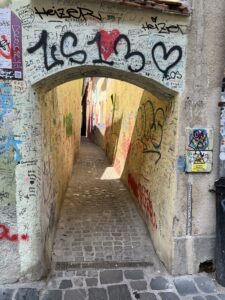
On the way from Bucharest to Brasov, the mountains got bigger and bigger and the leaves got brighter and brighter, and then very suddenly we were in peak-fall foliage in the Transylvania of my dreams. The anxiety I’d felt so strongly about nuclear tension in Ukraine had dissipated to nearly nothing—October in Transylvania felt like a bubble removed from the regular world.
Transylvania is a region in the middle of Romania surrounded by the Carpathian Mountains (also sometimes called the Transylvanian Alps). It’s a wild place known for legends, myths, an abundance of bears, Medieval towns, gothic architecture, and of course, Dracula. I am a person whose ideal aesthetic includes fall colors, cold nights, campfires, secrets, and anything beautifully spooky, and Transylvania could not have delivered this better.

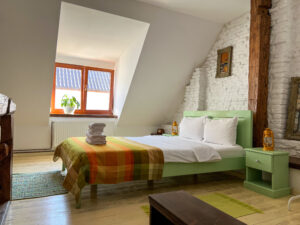

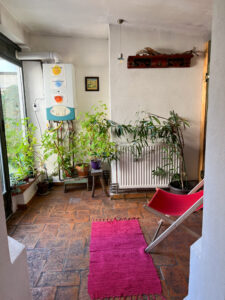
Romania is a very affordable country, so I decided to splurge and stay in a few Airbnbs instead of shared hostel rooms. I’d booked a beautiful Airbnb in Brasov that had excellent reviews and cost only $29 per night (the taxes and cleaning fees bumped it up closer to $40, but this was still less than I spent on many dorm beds in cramped shared rooms in Western Europe). It was the first Airbnb I stayed in without Michael, and I wondered if I’d feel nervous being in a strange house alone. I arrived at the Airbnb, used the gate code to enter into a small courtyard shared with one other apartment, and found the key hanging in the door. It was supposed to be locked in the lockbox according to the automated instructions I received 4 months prior when I made the reservation. But there it was, inserted into the keyhole. The lockbox wouldn’t open. I messaged the hosts on the Airbnb app to let them know, then went inside. I realized then that the hosts hadn’t communicated with me at all, not even when I made the reservation.
The house was as lovely as it looked in the photos, and the best part of all was the giant wooden bathtub—the main reason I’d booked the place. The problem was that I couldn’t find the plug to fill the tub. I messaged my hosts about this, as well. I kept checking my Airbnb app, waiting on their response. It never came. I was nervous to go to sleep in the house because I wasn’t sure that the owners were aware I’d checked in. I kept waiting for a cleaning crew to open the door unannounced. And though the entrance to the apartment was in an enclosed courtyard shared with just one other apartment and with a gate that locked, it was a very eerie feeling to know that the key had been hanging outside the house before I arrived where someone else might have had access to it.
The next day I still hadn’t received a reply from the hosts, so I contacted Airbnb support. They called me and let me know that they typically don’t have this problem with their “super hosts,” and that they would try to contact them since they had access to their personal phone number. They called me back to let me know that they couldn’t reach them either—not by phone, text, or email. Every review for the apartment was excellent, even from the guests who stayed a couple weeks before I did. I started to feel less annoyed and more worried—what if something terrible had happened to them? And then in the middle of the night, I woke up in the house and decided that my hosts had never been real. They were ghosts all along. Obviously. And could there be a more fitting way to visit Transylvania than in a beautiful ghost-Airbnb in the middle of October? They never did communicate with me. Not even once. And I never heard from Airbnb Support about whether they were okay or not. BUT all the reviews since my stay have been good. So I guess I can’t NOT recommend the ghosts as your hosts. The eerie feeling really enhances the whole Transylvania mystique. (And I found the plug for the bathtub as I was packing to leave, so I never got to use it.)
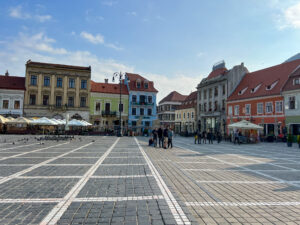

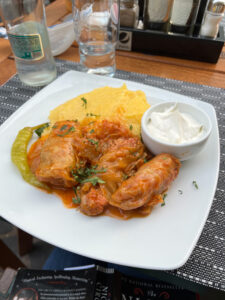


The incredibly well-preserved medieval center of Brasov looks like the setting for a fairytale, but somehow it maintains this without feeling inauthentic. There’s a lot of tourism here compared to the rest of Romania, but nowhere close to the level of mass tourism in the more visited countries of Europe. By comparison, it feels like you’ve stumbled upon a secret that the whole world will surely find out about soon. The main square in the Old Town is full of colorful buildings, elaborate baroque architecture and the largest gothic structure (the Black Church) in the country. Supposedly this was also the last location of witch-burning in Europe. It was once a walled city, and you can still see several of the watchtowers and part of the city walls today. I took a walking tour of the city to learn about the local history, and I ate things like the traditional Romanian dish sarmale–pork wrapped in cabbage, which sounds and looks gross but was actually delicious. It was cold at night—the coldest I’d been on my trip at that point—and I ate outside at restaurants that had giant heaters spaced throughout their tables and big wool blankets draped on the backs of chairs for every guest. It was exactly the right time of year to visit.
The two things I was most excited about during my stay in Brasov were two day-trips—one to Bran Castle and one to the Libearty Bear Sanctuary. Bran Castle is in the little town of Bran, just a 30-minute drive from Brasov. I booked a $38 tour on Viator to see it. Our driver picked me and a young couple from London up downtown and gave us a half-day tour of the surrounding area. He took us to Bran and gave us a guided tour of the Castle, then to get lunch, and then to nearby Rasnov to see the famous fortress there. Sometimes tours like this are not worth the money, and you can see the same things for far less money on your own. In a case like this, I absolutely recommend the tour. Public transportation between all of the small towns is not frequent, and you’d get far more out of seeing the castle with a guide than seeing it alone.
Bran Castle is famous for being the Dracula Castle—the Castle that Bram Stoker set Dracula the novel in. One of the first things you’ll learn when visiting Romania though is that Bram Stoker never even visited Romania. He saw the castle in a photo and liked the look of it, and according to our tour guide, he just liked the word Transylvania. The castle does a very good job of displaying the real history of the castle—the royal home of the beloved Queen Marie of Romania and later her daughter Princess Ileana—alongside information about the phenomenon of Dracula. Our tour guide didn’t want to talk about Dracula and rolled his eyes at the Dracula tourists—a considerable percentage of tourists who visit the region. BUT the truth is that there really was a Dracula. Whether Bram Stoker based his character entirely on Vlad the Impaler I can’t say for sure, but the fact is that Vlad the Impaler was also called Dracula, a name that meant “the son of the dragon,” and what I can guarantee you is that the real person Vlad the Impaler was even scarier than the fiction Dracula. No one knows if he ever even visited the town of Bran, much less the castle. Because of this, some people leave the castle disappointed because it wasn’t what they were expecting. I thought it was incredible. (I have a lot of thoughts about Dracula and dark tourism and the spookiness that people look for in Transylvania that can’t fit in this blog post, so be on the lookout for these thoughts in an upcoming post.)
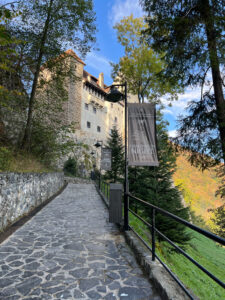
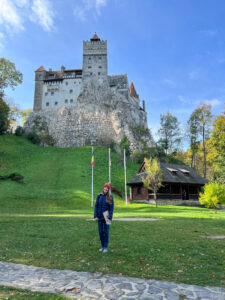

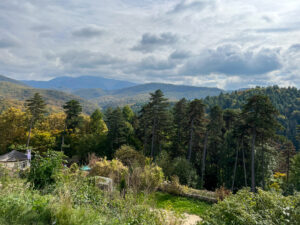
My second day trip was one that I almost didn’t do because it was such a challenge to figure out logistically. Romania has the largest bear (and wolf) population in Europe (by a lot). As an obsessive animal lover, I wondered if there was a way for me to see any of the Romanian wildlife that wasn’t ethically questionable, and I found The Libearty Bear Sanctuary Zarnesti. The Sanctuary is high in the hills near Rasnov—also a 30-minute drive from Brasov. With over 100 bears, it’s the largest brown bear sanctuary in the world, and I was desperate to go, but I couldn’t figure out how to get there. There is no public transportation there. There’s the option to take a bus to Rasnov and then call a taxi or an Uber, but it’s so far outside of town that chances are slim that you’d be able to summon a ride to pick you up. I read dozens of blogs and online posts about how others had done it, and most people seemed to rent cars. (I’m a nervous driver on even the most familiar roads, so this wasn’t happening.) Some people said they’d paid a taxi driver to wait for them at the Sanctuary, but this was expensive and there was a risk they wouldn’t agree to stay. And then finally I found a solution. I found an Airbnb Experience where I paid a flat rate for a pick-up and drop-off to and from the Sanctuary. It was $40, so relatively expensive when I added the price of the Sanctuary ticket (like $15) too, but it was 1000% worth it for the peace of mind.
My driver, Dan, picked me up from my Airbnb. I was the only guest that day, so it was just the two of us as we drove the 40 minutes to the Sanctuary. He was around my age and told me stories about growing up in Romania. We talked about culture, customs, history, and of course, the bears. He was one of the most friendly and personable people I met in Romania, and I learned as much from our casual chat in the car as I did from formal history tours. We passed shepherds and their sheep herds and watched the mountains alongside us as we rose higher into the hills. The road turned to dirt as we got higher in the mountains. We finally arrived at the Sanctuary, and Dan helped me buy my ticket and waited for me outside.
The Libearty Bear Sanctuary is a magical place. They rescue bears, and some other animals, from captivity and re-home and rehabilitate them on their land. The bears can never be released back into the wild because they’ve always lived in captivity and they wouldn’t survive on their own, but at the Sanctuary, they have this massive forest to themselves to relax and live the rest of their lives. Most of the bears have horribly sad stories. A lot of them were rescued from terrible private zoos or circuses. Some of them were owned by individuals who used them for photo ops with tourists in front of local attractions (which was legal until recently). A lot of them lived in tiny cages their whole lives. A few of them are being treated for cancer. One of them is blind. There are even a few Ukrainian refugees there (bears and wolves) who were rescued from Ukrainian zoos after the war broke out.
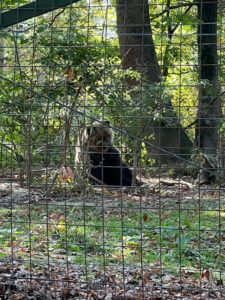


This is NOT a zoo. It’s important to the Sanctuary that people know that. Visitors are only allowed for a couple of hours per day and only on one of 2 guided tours offered during that time. The bears don’t live in cages—they roam inside the reservation freely. Places like this are eye-opening about how often animals are harmed for the sake of tourism. Though they are now a protected species in Romania, it’s still legal in several surrounding countries for individuals to own bears. Libearty is working hard to change things here. It’s so inspiring and unbelievably beautiful.
Dan dropped me off at the train station—I’d brought my luggage when I checked out of the Airbnb that morning and left it in his car while seeing the bears. If you ever visit Transylvania, I can’t recommend the Libearty Bear Sanctuary and this driving service enough. I had a couple of hours to wait until my train which wasn’t enough time to go back to the Old Town, so I walked to a nearby mall that had a lot of restaurant options. I was shocked to find one of the most modern and beautiful malls I’ve ever seen. The fancy food court opened onto a second-floor outdoor terrace amid the treetops of fall foliage. I had only seen the medieval tourist area of town before this, but the fancy mall revealed to me that Brasov also has plenty of modern amenities and that we should probably all move there immediately. There are dozens of places in Europe that I dream of going back to daily, and Brasov is very high on that list.
